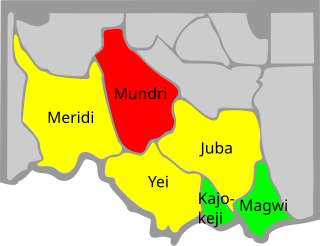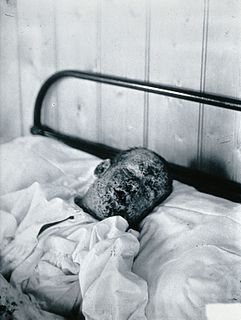
Diethylcarbamazine (DEC) is a medication used in the treatment of filariasis including lymphatic filariasis, tropical pulmonary eosinophilia, and loiasis. It may also be used for prevention of loiasis in those at high risk. While it has been used for onchocerciasis, ivermectin is preferred. It is taken by mouth.

Onchocerciasis, also known as river blindness, is a disease caused by infection with the parasitic worm Onchocerca volvulus. Symptoms include severe itching, bumps under the skin, and blindness. It is the second-most common cause of blindness due to infection, after trachoma.

Filariasis is a parasitic disease caused by an infection with roundworms of the Filarioidea type. These are spread by blood-feeding insects such as black flies and mosquitoes. They belong to the group of diseases called helminthiases.

Keratitis is a condition in which the eye's cornea, the clear dome on the front surface of the eye, becomes inflamed. The condition is often marked by moderate to intense pain and usually involves any of the following symptoms: pain, impaired eyesight, photophobia, red eye and a 'gritty' sensation.
Tropical diseases are diseases that are prevalent in or unique to tropical and subtropical regions. The diseases are less prevalent in temperate climates, due in part to the occurrence of a cold season, which controls the insect population by forcing hibernation. However, many were present in northern Europe and northern America in the 17th and 18th centuries before modern understanding of disease causation. The initial impetus for tropical medicine was to protect the health of colonial settlers, notably in India under the British Raj. Insects such as mosquitoes and flies are by far the most common disease carrier, or vector. These insects may carry a parasite, bacterium or virus that is infectious to humans and animals. Most often disease is transmitted by an insect "bite", which causes transmission of the infectious agent through subcutaneous blood exchange. Vaccines are not available for most of the diseases listed here, and many do not have cures.

Ivermectin is a medication used to treat many types of parasite infestations. This includes head lice, scabies, river blindness (onchocerciasis), strongyloidiasis, trichuriasis, ascariasis, and lymphatic filariasis. It can be taken by mouth or applied to the skin for external infestations. Use in the eyes should be avoided.

Onchocerca volvulus is a nematode that causes onchocerciasis, and is the second-leading cause of blindness worldwide after trachoma. It is one of the 20 neglected tropical diseases listed by the World Health Organization, with elimination from certain countries expected by 2020.

The population of Africa has grown rapidly over the past century and consequently shows a large youth bulge, further reinforced by a low life expectancy of below 50 years in some African countries. Total population as of 2020 is estimated at more than 1.341 billion, with a growth rate of more than 2.5% p.a. The total fertility rate for Sub-Saharan Africa is 4.7 as of 2018, the highest in the world according to the World Bank. The most populous African country is Nigeria with over 206 million inhabitants as of 2020 and a growth rate of 2.6% p.a.

Lymphatic filariasis is a human disease caused by parasitic worms known as filarial worms. Most cases of the disease have no symptoms. Some people, however, develop a syndrome called elephantiasis, which is marked by severe swelling in the arms, legs, breasts, or genitals. The skin may become thicker as well, and the condition may become painful. The changes to the body have the potential to harm the person's social and economic situation.

Neglected tropical diseases (NTDs) are a diverse group of tropical infections which are common in low-income populations in developing regions of Africa, Asia, and the Americas. They are caused by a variety of pathogens such as viruses, bacteria, protozoa and parasitic worms (helminths). These diseases are contrasted with the big three infectious diseases, which generally receive greater treatment and research funding. In sub-Saharan Africa, the effect of these diseases as a group is comparable to malaria and tuberculosis. NTD co-infection can also make HIV/AIDS and tuberculosis more deadly.

Nodding disease is a disease which emerged in Sudan in the 1960s. It is a mentally and physically disabling disease that only affects children, typically between the ages of 5 and 15. It is currently restricted to small regions in South Sudan, Tanzania, and northern Uganda. Prior to the South Sudan outbreaks and subsequent limited spread, the disease was first described in 1962 existing in secluded mountainous regions of Tanzania, although the connection between that disease and nodding syndrome was only made recently.

Eradication is the reduction of an infectious disease's prevalence in the global host population to zero. It is sometimes confused with elimination, which describes either the reduction of an infectious disease's prevalence in a regional population to zero, or the reduction of the global prevalence to a negligible amount. Further confusion arises from the use of the term eradication to refer to the total removal of a given pathogen from an individual, particularly in the context of HIV and certain other viruses where such cures are sought.

The Filarioidea are a superfamily of highly specialised parasitic nematodes. Species within this superfamily are known as filarial worms or filariae. Infections with parasitic filarial worms cause disease conditions generically known as filariasis. Drugs against these worms are known as filaricides.
United Front Against Riverblindness (UFAR) is a Non-Governmental Development Organization (NGDO) that provides technical, managerial and financial support for the elimination of riverblindness, or onchocerciasis, in the Kasongo region of Maniema province in the east-southern region of the Democratic Republic of the Congo (DRC).
Sightsavers is an international non-governmental organisation that works with partners in developing countries to treat and prevent avoidable blindness, and promote equality for people with visual impairments and other disabilities. It is based in Haywards Heath in the United Kingdom, with branches in Sweden, Norway, India, Italy, Republic of Ireland, the United Arab Emirates, and the USA.

The Organisation for the Prevention of Blindness is an international non-governmental organisation whose actions today focus exclusively on French-speaking countries in West Africa. Their mission is to preserve and restore sight amongst some of the most under-privileged communities in the region. The OPC's principal actions concern blindness prevention, treatment and the elimination of blinding diseases, such as onchocerciasis, trachoma, glaucoma and cataracts as well as formal ophthalmological training.
Uche Veronica Amazigo is a professor of Medical Parasitology and public health specialist. She is a fellow of the Nigerian Academy of Science who was elected into the Academy's Fellowship at its Annual General Meeting held in January, 2015. In 2012, she won the Prince Mahidol Award for outstanding contributions to public health. She is best known for her research on onchocerciasis and her consequent contributions to the World Health Organization (WHO).
Ekanem Ikpi Braide is a Nigerian Parasitologist She attended St Anne's School Ibadan for her secondary school education and who was a Vice-Chancellor of Cross River University of Technology (CRUTECH), Calabar, and pioneer Vice-Chancellor of Federal University of Technology, Lafia. She is credited with a major contribution to the eradication of guinea worm in Nigeria. In 2020, she was made the first female President-elect of the Nigerian Academy of Science. Braide is Chairman of the Board of Trustees, The Leprosy Mission (TLM) Nigeria. She is the Pro-Chancellor of Arthur Jarvis University, Akpabuyo, Nigeria.

Professor Ikechukwu Nosike Simplicius Dozie is a professor of Microbiology (Medical Microbiology & Parasitology, a public health scientist, teacher and community health specialist currently serving at the Department of Public Health, Federal University of Technology Owerri, Nigeria. He is a member of American Society of Tropical Medicine & Hygiene. Dozie was a consultant to the World Health Organisation; WHO’s African programme for Onchocerciasis. He is the Director, Linkages and Advancement, Federal University of Technology Owerri.

The Boro River is a river of South Sudan, a headwater of the Magadhik River, which in turn is a headwater of the Lol River.















